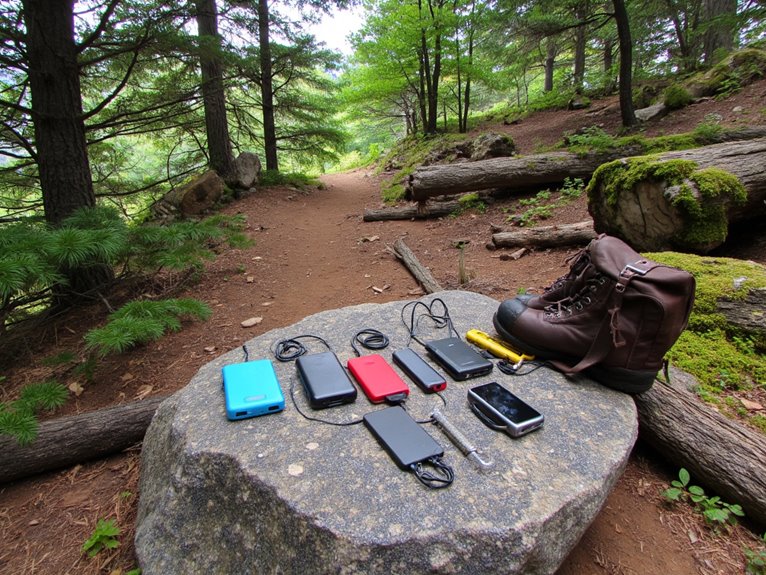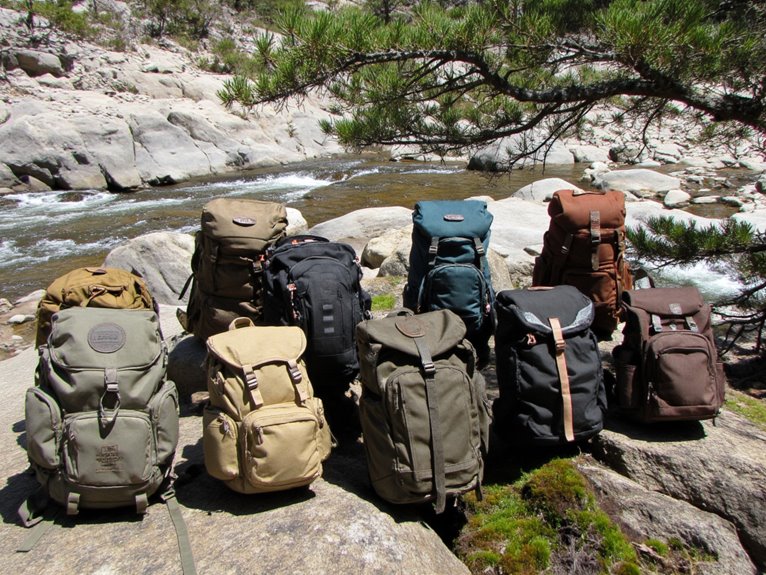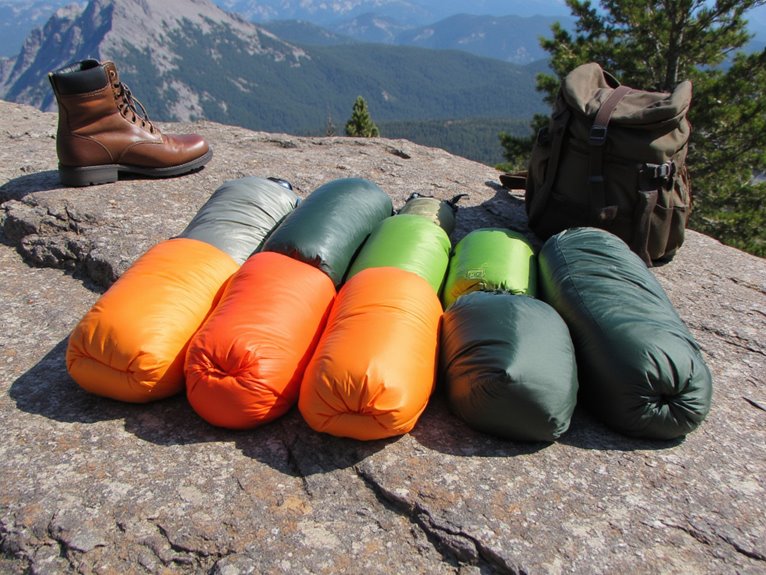What Is the Difference Between Hiking and Tramping?
Hiking and tramping, two outdoor activities often used interchangeably, have distinct historical, cultural, and practical differences that set them apart. Hiking originated in the United States, tied to the American conservation movement and national parks, while tramping has its roots in the British working-class tradition of taking long, leisurely walks in the countryside. These differing origins have shaped unique norms, practices, and cultural associations that continue to influence their modern practice. As we delve further, the nuances of terrain, equipment, physical demands, and social aspects will reveal a richer understanding of these two outdoor pursuits.
We are supported by our audience. When you purchase through links on our site, we may earn an affiliate commission, at no extra cost for you. Learn more. Last update on 6th January 2026 / Images from Amazon Product Advertising API.
Origins of Hiking and Tramping
The etymological roots of hiking and tramping, two outdoor pursuits often used interchangeably, reveal distinct cultural and historical contexts that have shaped their modern practice. Hiking, a term originating in the United States in the late 19th century, is closely tied to the American conservation movement and the establishment of national parks. In contrast, tramping, a term commonly used in New Zealand and the UK, has its roots in the British working-class tradition of taking long, leisurely walks in the countryside. This cultural dichotomy reflects the unique historical and social contexts of each region, influencing the development of these outdoor activities. As a result, hiking and tramping have evolved with distinct norms, practices, and cultural associations that continue to shape their modern practice.
Terrain and Trail Types
Mountainous landscapes, rugged coastlines, and rolling hills form the diverse terrain that hiking and tramping enthusiasts navigate, with trails ranging from well-trodden paths to remote, unmarked routes that challenge even the most seasoned adventurers. From the steep, rocky inclines of alpine trails to the dense, humid environments of tropical rainforests, the variety of terrain presents unique challenges and opportunities for exploration. Trails can be narrow and winding, following ancient routes or newly forged paths, or they can be broad and well-maintained, accommodating large numbers of hikers and trampers. Regardless of the terrain, hikers and trampers must be prepared to adapt to changing conditions, relying on their skills, experience, and judgment to navigate the diverse landscapes they encounter.
Level of Difficulty and Challenge
Difficulty levels in hiking and tramping vary widely, with some trails posing significant physical and mental challenges, while others offer more leisurely strolls through serene landscapes. Hiking trails, particularly those in national parks, often have well-marked paths and gentle inclines, making them accessible to a broader range of participants. In contrast, tramping trails, often found in more remote areas, can be rugged, steep, and demanding, requiring a higher level of physical fitness and outdoor expertise. The level of difficulty and challenge can also depend on factors such as weather conditions, terrain, and altitude, making it essential for participants to carefully assess their capabilities and prepare accordingly.
Cultural Significance and History
As we examine the cultural significance and history of hiking and tramping, it becomes clear that these outdoor pursuits have been shaped by distinct cultural and socioeconomic factors. In Europe, hiking emerged as a popular pastime among the aristocracy, while in New Zealand, tramping was influenced by the indigenous Maori people's deep connection with the natural environment. Meanwhile, tramping's working-class roots in the UK and Australia reveal a more egalitarian and utilitarian approach to outdoor recreation.
Early Adoption in Europe
In the midst of Europe's Romantic era, when the Industrial Transformation was reshaping the continent's social and economic landscape, a fascination with the great outdoors began to take root, laying the groundwork for the eventual distinction between hiking and tramping. As urbanization accelerated, people sought refuge in nature, sparking a cultural shift towards appreciation for the natural world. The early 19th century saw the emergence of alpine clubs, where enthusiasts shared knowledge and ventured into the European wilderness. This nascent interest in outdoor pursuits paved the way for the development of distinct hiking and tramping traditions, each with its unique cultural and historical context. As the European outdoors became a space for recreation and self-discovery, the seeds of a deeper connection with nature were sown.
Maori Influence in NZ
The Antipodean landscape, where the rugged mountains and pristine fjords of New Zealand's wilderness converged with the rich cultural heritage of its indigenous Maori people, became a fertile ground for the evolution of tramping, imbuing the outdoor pursuit with a unique cultural significance.
As tramping developed, it absorbed the Maori concept of "turangawaewae," or a sense of place and connection to the land. This cultural fusion imbued tramping with a deep respect for the natural environment and a sense of reverence for the land.
- Misty valleys shrouded in ancient myths and legends
- Whispers of ancestral spirits echoing through the forest
- Ancient trails worn by the feet of Maori ancestors
- The rhythmic pulse of the haka, echoing through the mountains
Tramping's Working-Class Roots
How did tramping, an activity often associated with the elite and the privileged, emerge from the rugged, no-nonsense world of New Zealand's working class? The answer lies in the country's industrial past. In the late 19th and early 20th centuries, workers from the mines, railways, and forests would often venture into the wilderness on their days off, seeking adventure and escape from the hardships of their daily lives. These early trampers were not affluent outdoor enthusiasts, but rather ordinary people seeking freedom and recreation in the great outdoors. As the working-class roots of tramping took hold, the activity became an integral part of New Zealand's cultural identity, fostering a sense of community and camaraderie among its practitioners. This humble beginnings story serves as a tribute to the democratization of outdoor recreation in New Zealand.
Equipment and Gear Needed
As we shift from the cultural significance and history of hiking and tramping to the practical aspects of these outdoor pursuits, it becomes essential to examine the equipment and gear needed to safeguard a safe and enjoyable experience. The essential items that every hiker or tramper should carry, such as first aid kits, navigation tools, and emergency shelters, are vital to ponder. From backpack essentials to trail footwear choices and camping gear options, the right equipment can make all the difference in tackling challenging terrain and unpredictable weather conditions.
Backpack Essentials
Every outdoor enthusiast knows that a well-packed backpack is essential to a successful hiking or tramping trip. A thoughtfully curated backpack can be the difference between a comfortable, enjoyable journey and a miserable, exhausting one.
When assembling the perfect backpack, consider the following essentials:
- Water bottle or hydration bladder: staying hydrated is vital, especially in remote areas
- First aid kit: a basic kit should include bandages, antiseptic wipes, and pain relievers
- Map and compass: even with GPS, a physical map and compass can be a lifesaver
- Extra layers and rain gear: unpredictable weather can quickly turn a pleasant hike into a hypothermic nightmare
Trail Footwear Choices
Trail footwear is a critical component of a hiker's or tramper's equipment arsenal, as it can make all the difference between a comfortable, blister-free journey and a miserable, foot-sore experience. When selecting trail footwear, consider the terrain, distance, and weather conditions of your outing. Hiking boots or shoes with sturdy soles, breathable uppers, and adequate ankle support are essential for rugged trails. For shorter, more leisurely strolls, trail running shoes or lightweight hiking shoes may suffice. Look for waterproofing or water-resistance, especially in wet or snowy conditions. Don't forget to break in your footwear before setting out on a long trip to prevent blisters and discomfort. Properly fitting, high-quality trail footwear can be a game-changer, ensuring a safe, enjoyable, and memorable hiking or tramping experience.
Camping Gear Options
Typically, a well-planned camping gear list is essential for a comfortable and enjoyable hiking or tramping excursion, as it directly impacts the quality of one's outdoor experience. Having the right equipment can make all the difference between a pleasant adventure and a miserable one.
- A sturdy, waterproof tent to provide shelter from the elements
- A warm, insulated sleeping bag to guarantee a good night's rest
- A portable stove and cooking pot to prepare nourishing meals
- A reliable water filter or purification tablets to access safe drinking water
Accurate navigation and route finding are essential skills for hikers and trampers alike, as they venture into the wilderness, often relying on maps, compasses, and GPS devices to stay on course. Effective navigation involves understanding topographic maps, recognizing landmarks, and using celestial navigation techniques. Additionally, hikers and trampers must be able to read natural signs, such as animal tracks, water flow, and vegetation patterns, to stay on track. Moreover, they must also be prepared to adapt to changing weather conditions and unexpected obstacles. By mastering these skills, outdoor enthusiasts can confidently venture into remote areas, reducing the risk of getting lost and ensuring a safer, more enjoyable experience. In addition, they can discover new territories, reducing the risk of getting lost and ensuring a safer, more enjoyable experience.
Physical Demands and Fitness
When it comes to hiking and tramping, physical demands and fitness play a crucial role in determining one's ability to complete a trip successfully. The physical demands of both activities require a certain level of endurance and strength, as well as a strong cardiovascular fitness level. Understanding the specific physical demands of each activity is essential to preparing oneself for the challenges that lie ahead.
Endurance and Strength Needed
Hiking and tramping require distinct levels of physical fitness and strength, as each activity presents unique demands on the body. While hiking typically involves shorter distances and more established trails, tramping often requires traversing rugged terrain, overcoming obstacles, and carrying heavier packs.
To tackle these challenges, trampers need:
- Strong legs and core muscles to handle steep inclines and uneven terrain
- Endurance to sustain long hours of physical activity
- Upper body strength to maneuver through dense vegetation and over obstacles
- Agility and balance to traverse treacherous terrain and avoid hazards
Cardiovascular Fitness Level
Traversing rugged landscapes and tackling demanding trails requires a robust cardiovascular system, capable of efficiently delivering oxygen and nutrients to the muscles, to sustain prolonged periods of physical exertion. A high level of cardiovascular fitness is essential for both hiking and tramping, as it enables the body to adapt to changing terrain, elevation, and weather conditions. A well-conditioned cardiovascular system allows for more efficient oxygenation of the muscles, reducing fatigue and improving overall endurance. In addition, it improves the body's ability to recover between intense physical efforts, enabling hikers and trampers to tackle challenging trails with confidence. A strong cardiovascular system is a critical component of overall fitness, and its development should be a primary focus for those seeking to excel in these outdoor pursuits. Additionally, it boosts the body's ability to recover between intense physical efforts, enabling hikers and trampers to tackle challenging trails with confidence.
Muscle Groups Used
As both hiking and tramping require sustained periods of physical exertion, a range of muscle groups are engaged to maintain posture, generate power, and facilitate movement across varied terrain. The physical demands of these outdoor activities necessitate the activation of multiple muscle groups to facilitate efficient and safe progression.
- The quadriceps and hamstrings in the legs are engaged to propel the body upward and forward, while the glutes and core muscles provide stability and balance.
- The calf muscles are activated to absorb the shock of each step and propel the body forward.
- The shoulders and back muscles are engaged to maintain posture and stabilize the body, particularly when carrying a heavy backpack.
- The arm muscles are used to assist with balance and provide additional propulsion when traversing challenging terrain.
Environmental Impact and Awareness
Outdoor enthusiasts often overlook the subtle yet profound impact their recreational activities have on the natural environment, underscoring the need for heightened environmental awareness in the pursuit of hiking and tramping. As we venture into the wilderness, our footprints, litter, and campfires can disrupt delicate ecosystems, threatening native species and habitats. It is vital that hikers and trampers adopt sustainable practices, such as carrying out trash, respecting wildlife habitats, and minimizing campfire use. By adopting environmentally conscious habits, we can mitigate the negative consequences of our recreational activities and preserve the natural beauty of our planet for future generations. By doing so, we can guarantee that our passion for hiking and tramping does not come at the expense of the environment.
Social Aspects and Group Dynamics
One of the most significant, yet often overlooked, aspects of hiking and tramping is the complex social dynamic that emerges when individuals come together to venture into the wilderness. The camaraderie, shared experiences, and mutual support that develop during these excursions can be incredibly enriching.
- The sound of laughter and storytelling around the campfire, accompanied by the crackling of flames and the starry night sky
- The silent understanding and trust that develops between hiking partners as they navigate treacherous terrain
- The collective sense of accomplishment and pride when reaching a summit or completing a challenging section
- The bonds formed over shared meals and campfire cooking, as strangers become friends and memories are forged
Regional Variations and Nuances
Regional hiking and tramping traditions reveal distinct flavors shaped by the unique cultural, geographical, and environmental characteristics of their respective regions. For instance, the rugged terrain of New Zealand's Southern Alps has given rise to a tramping culture that emphasizes self-reliance and resilience. In contrast, the well-marked trails and picturesque villages of the European Alps have fostered a more leisurely, socially-oriented hiking culture. Meanwhile, the vast wilderness areas of North America have spawned a hiking tradition that values solitude and immersion in nature. By acknowledging and appreciating these regional variations, outdoor enthusiasts can delve deeper into their understanding and appreciation of the diverse ways in which humans interact with the natural world.



